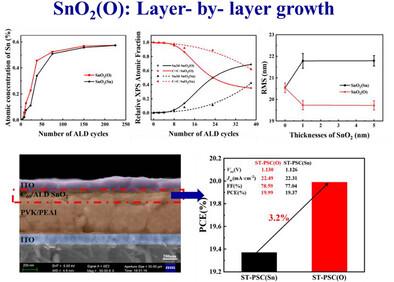Atomic Layer Deposited Tin Oxide Buffer Layer via Layer-by-layer Growth for Efficient Semitransparent Perovskite Solar Cells
IF 12.1
2区 材料科学
Q1 CHEMISTRY, MULTIDISCIPLINARY
引用次数: 0
Abstract
Atomic layer deposition (ALD) of compact tin oxide (SnO2) sputtering buffer layer plays a crucial role in high-performance semitransparent perovskite solar cells (ST-PSCs) and perovskite/silicon tandem solar cells. However, when the substrate exhibits low reactivity with the ALD reactants, the ALD process tends to follow an island growth mode, leading to a prolonged incubation period and pinhole films, which ultimately degrade device performance. In this study, the substrate is activated by simply altering precursor introduced sequence, switching from introducing the tin precursor first to introducing the oxygen precursor first. The hydroxyl groups generated by the oxygen precursor enhance nucleation sites on the substrate, allowing the initial ALD films growth transforming from island-like mode to layer-by-layer mode, resulting in dense and vertically uniform SnO2 films. Semitransparent PSCs constructed with dense ALD SnO2 layer effectively mitigate sputtering-induced damage and improve the interface properties. As a result, the initial power conversion efficiency (PCE) of the ST-PSC increased from 19.37% to 19.99%, corresponding to the improvement by 3.2%. The perovskite/silicon tandem solar cells are also fabricated with PCE of 28.77%. Furthermore, ST-PSCs with dense ALD SnO2 layer exhibit improved moisture and thermal stability, which maintain 96.6% and 95.6% of initial PCE after being stored at relative humidity of 30% for 600 h and 85 °C for 600 h, respectively. This study provides a simple and effective approach for fabricating dense and uniform ALD SnO2 buffer layers, demonstrating their potential application not only in efficient semitransparent perovskite solar cells and tandem solar cells but also in other optoelectrical devices.

高效半透明钙钛矿太阳能电池的原子层沉积氧化锡缓冲层的逐层生长
致密氧化锡(SnO2)溅射缓冲层的原子层沉积(ALD)在高性能半透明钙钛矿太阳能电池(ST-PSCs)和钙钛矿/硅串联太阳能电池中起着至关重要的作用。然而,当衬底与ALD反应物的反应性较低时,ALD过程倾向于遵循岛生长模式,导致孵化期延长和针孔膜,最终降低器件性能。在本研究中,通过简单地改变前驱体引入顺序来激活底物,从先引入锡前驱体切换到先引入氧前驱体。氧前驱体生成的羟基增强了底物上的成核位点,使初始ALD薄膜从岛状模式转变为逐层模式,形成致密且垂直均匀的SnO2薄膜。采用致密的ALD SnO2层构建的半透明PSCs有效地减轻了溅射引起的损伤,改善了界面性能。结果,ST-PSC的初始功率转换效率(PCE)从19.37%提高到19.99%,相应提高了3.2%。制备了PCE为28.77%的钙钛矿/硅串联太阳能电池。此外,具有致密ALD SnO2层的st - psc表现出更好的湿热稳定性,在相对湿度为30%的条件下储存600 h和85°C条件下储存600 h后,其PCE分别保持在初始PCE的96.6%和95.6%。本研究为制备致密均匀的ALD SnO2缓冲层提供了一种简单有效的方法,证明了其不仅在高效半透明钙钛矿太阳能电池和串联太阳能电池中,而且在其他光电器件中具有潜在的应用前景。
本文章由计算机程序翻译,如有差异,请以英文原文为准。
求助全文
约1分钟内获得全文
求助全文
来源期刊

Small
工程技术-材料科学:综合
CiteScore
17.70
自引率
3.80%
发文量
1830
审稿时长
2.1 months
期刊介绍:
Small serves as an exceptional platform for both experimental and theoretical studies in fundamental and applied interdisciplinary research at the nano- and microscale. The journal offers a compelling mix of peer-reviewed Research Articles, Reviews, Perspectives, and Comments.
With a remarkable 2022 Journal Impact Factor of 13.3 (Journal Citation Reports from Clarivate Analytics, 2023), Small remains among the top multidisciplinary journals, covering a wide range of topics at the interface of materials science, chemistry, physics, engineering, medicine, and biology.
Small's readership includes biochemists, biologists, biomedical scientists, chemists, engineers, information technologists, materials scientists, physicists, and theoreticians alike.
 求助内容:
求助内容: 应助结果提醒方式:
应助结果提醒方式:


